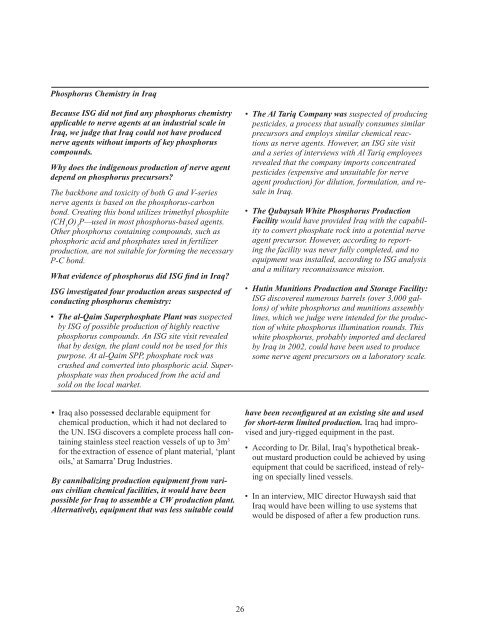Comprehensive Report
GPO-DUELFERREPORT-3
GPO-DUELFERREPORT-3
- No tags were found...
You also want an ePaper? Increase the reach of your titles
YUMPU automatically turns print PDFs into web optimized ePapers that Google loves.
Phosphorus Chemistry in Iraq<br />
Because ISG did not find any phosphorus chemistry<br />
applicable to nerve agents at an industrial scale in<br />
Iraq, we judge that Iraq could not have produced<br />
nerve agents without imports of key phosphorus<br />
compounds.<br />
Why does the indigenous production of nerve agent<br />
depend on phosphorus precursors?<br />
The backbone and toxicity of both G and V-series<br />
nerve agents is based on the phosphorus-carbon<br />
bond. Creating this bond utilizes trimethyl phosphite<br />
(CH 3<br />
O) 3<br />
P—used in most phosphorus-based agents.<br />
Other phosphorus containing compounds, such as<br />
phosphoric acid and phosphates used in fertilizer<br />
production, are not suitable for forming the necessary<br />
P-C bond.<br />
What evidence of phosphorus did ISG find in Iraq?<br />
ISG investigated four production areas suspected of<br />
conducting phosphorus chemistry:<br />
• The al-Qaim Superphosphate Plant was suspected<br />
by ISG of possible production of highly reactive<br />
phosphorus compounds. An ISG site visit revealed<br />
that by design, the plant could not be used for this<br />
purpose. At al-Qaim SPP, phosphate rock was<br />
crushed and converted into phosphoric acid. Superphosphate<br />
was then produced from the acid and<br />
sold on the local market.<br />
• The Al Tariq Company was suspected of producing<br />
pesticides, a process that usually consumes similar<br />
precursors and employs similar chemical reactions<br />
as nerve agents. However, an ISG site visit<br />
and a series of interviews with Al Tariq employees<br />
revealed that the company imports concentrated<br />
pesticides (expensive and unsuitable for nerve<br />
agent production) for dilution, formulation, and resale<br />
in Iraq.<br />
• The Qubaysah White Phosphorus Production<br />
Facility would have provided Iraq with the capability<br />
to convert phosphate rock into a potential nerve<br />
agent precursor. However, according to reporting<br />
the facility was never fully completed, and no<br />
equipment was installed, according to ISG analysis<br />
and a military reconnaissance mission.<br />
• Hutin Munitions Production and Storage Facility:<br />
ISG discovered numerous barrels (over 3,000 gallons)<br />
of white phosphorus and munitions assembly<br />
lines, which we judge were intended for the production<br />
of white phosphorus illumination rounds. This<br />
white phosphorus, probably imported and declared<br />
by Iraq in 2002, could have been used to produce<br />
some nerve agent precursors on a laboratory scale.<br />
• Iraq also possessed declarable equipment for<br />
chemical production, which it had not declared to<br />
the UN. ISG discovers a complete process hall containing<br />
stainless steel reaction vessels of up to 3m 3<br />
for the extraction of essence of plant material, ‘plant<br />
oils,’ at Samarra’ Drug Industries.<br />
By cannibalizing production equipment from various<br />
civilian chemical facilities, it would have been<br />
possible for Iraq to assemble a CW production plant.<br />
Alternatively, equipment that was less suitable could<br />
have been reconfigured at an existing site and used<br />
for short-term limited production. Iraq had improvised<br />
and jury-rigged equipment in the past.<br />
• According to Dr. Bilal, Iraq’s hypothetical breakout<br />
mustard production could be achieved by using<br />
equipment that could be sacrificed, instead of relying<br />
on specially lined vessels.<br />
• In an interview, MIC director Huwaysh said that<br />
Iraq would have been willing to use systems that<br />
would be disposed of after a few production runs.<br />
26


